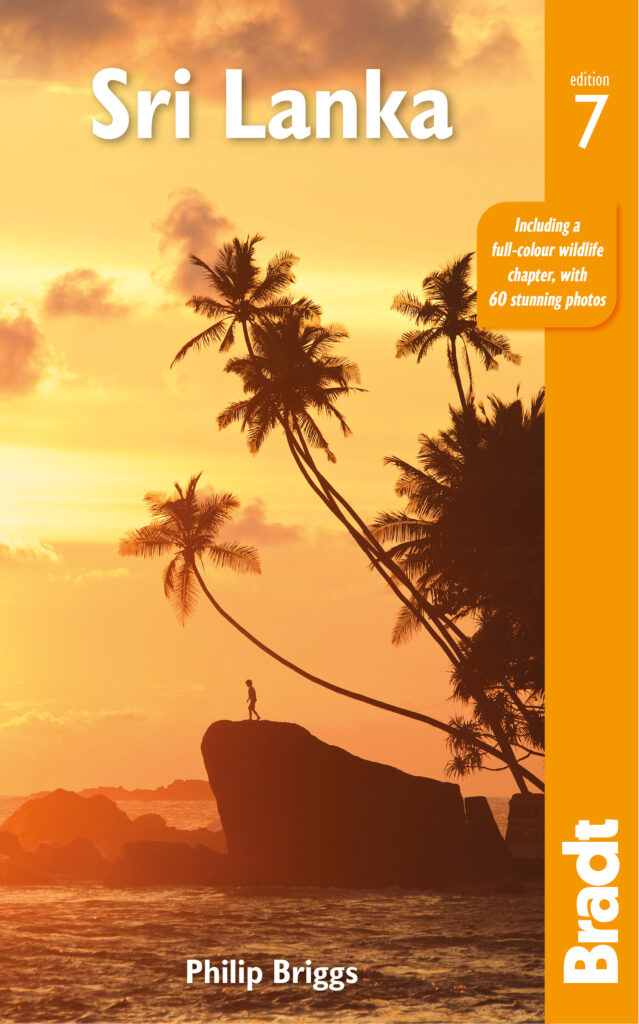Join Abigail King as she uncovers the meaning behind Sri Lanka’s traditional masks. From demons to dancing, each one reveals a deeper cultural truth.
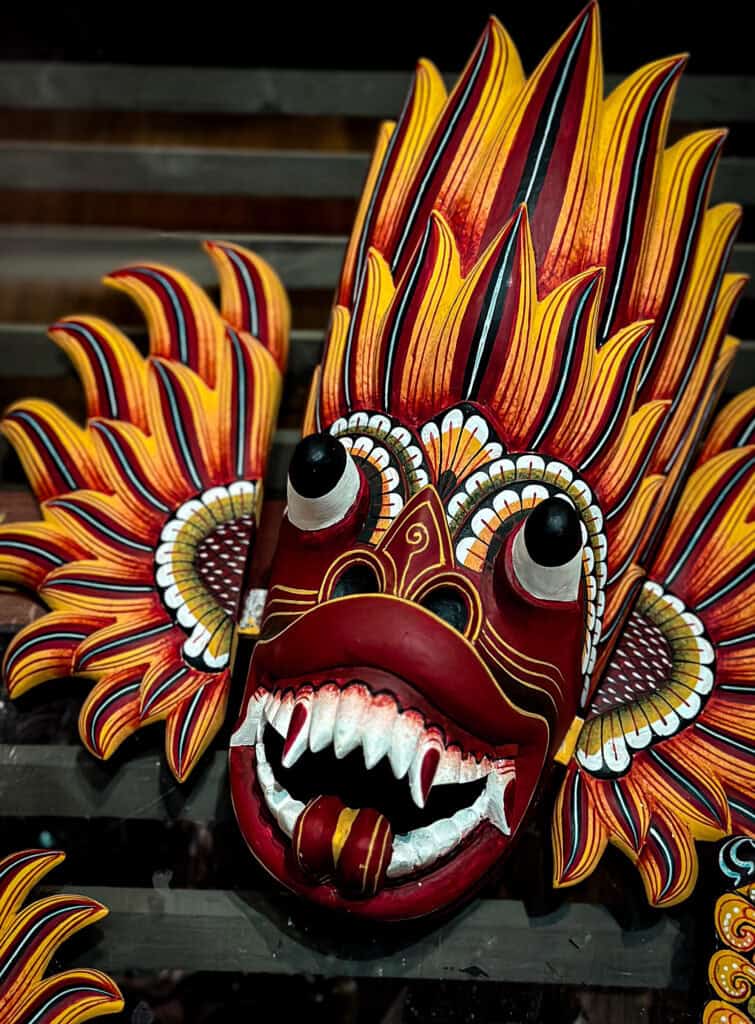
Sri Lanka’s traditional masks tell stories
His eyes bulge, pupils motionless and inky black, cheeks engorged, smile malevolent. A man grabs my hand in the sticky, sticky heat, curling my fingers around the blade and driving it forward, twisting it again, and again, again, and again, deeper and harder before stopping to mop his brow.
We’re in Galle in southern Sri Lanka, a windswept port with old stone ramparts, and years of tradition. If you left the palm trees by the crashing waves and followed a line of twinkling lights, you’d walk through this UNESCO World Heritage Site to reach me, a first time visitor, in a small workshop, learning about traditional masks. You’d also find Janaka De Silva, an artist and creator, and his assistants, Chimanda and Harin following the hands on approach to a tee.
Sri Lanka, formerly Ceylon, is one of those countries whose name I grew up hearing but whose identity, on reflection, swirls around a little when it comes to the details, like the teardrops on lotus leaves at dawn.
Or balsa wood on the bench, in my current, rather less poetic, situation.
Hand carved wooden masks are a colourful tradition in Sri Lanka. They come in three general forms. To vastly oversimplify, they are: Raksha for dances and festivals, Sanni for healing and Kolam, with character faces, for storytelling and satire.
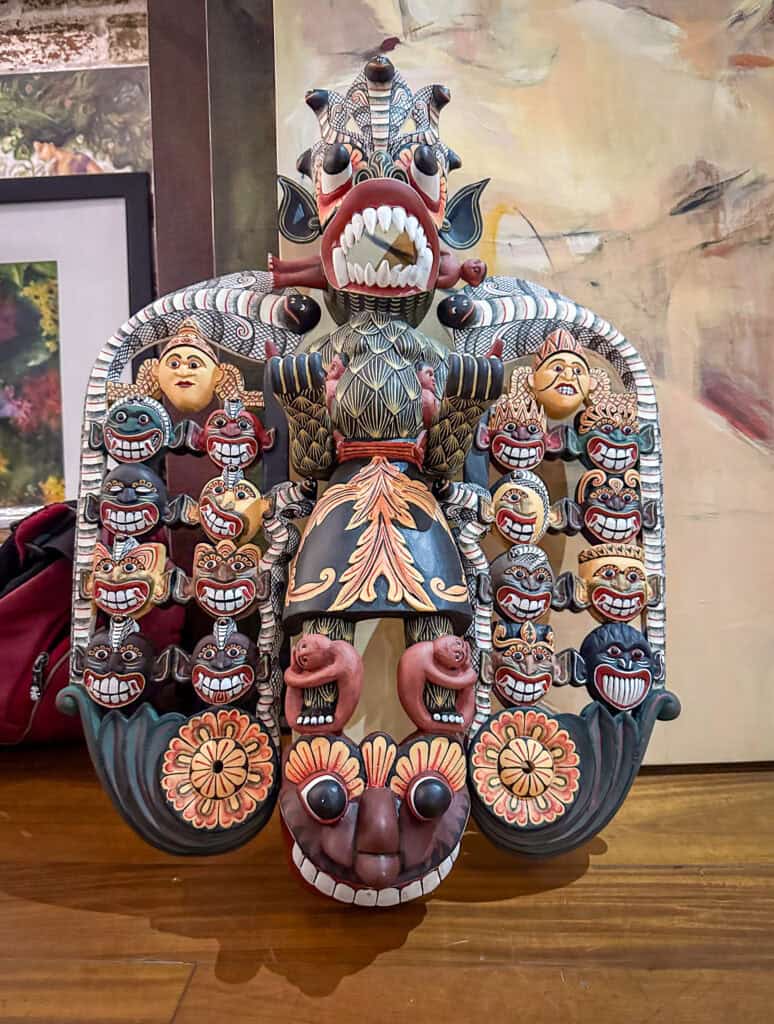
The stories and facts behind the masks
The gallery walls are lined with them: the scarlet cobra Naga that captures and enslaves its enemies, the hawk Gurulu who rescues them, the fire devil who projects anger and the peacock, who promotes peace.
All in, there are 24 forms of Raksha masks, a tribute to the rakshahasa people who lived in ancient Sri Lanka. Eighteen different sanni masks cure different diseases in a Sinhalese exorcism ritual and the kolam masks resemble a much more sophisticated version of Punch and Judy. There’s a panikkalaya, wives, soldiers and even a village chief.
But most of the ones on display here come from the raksha family.
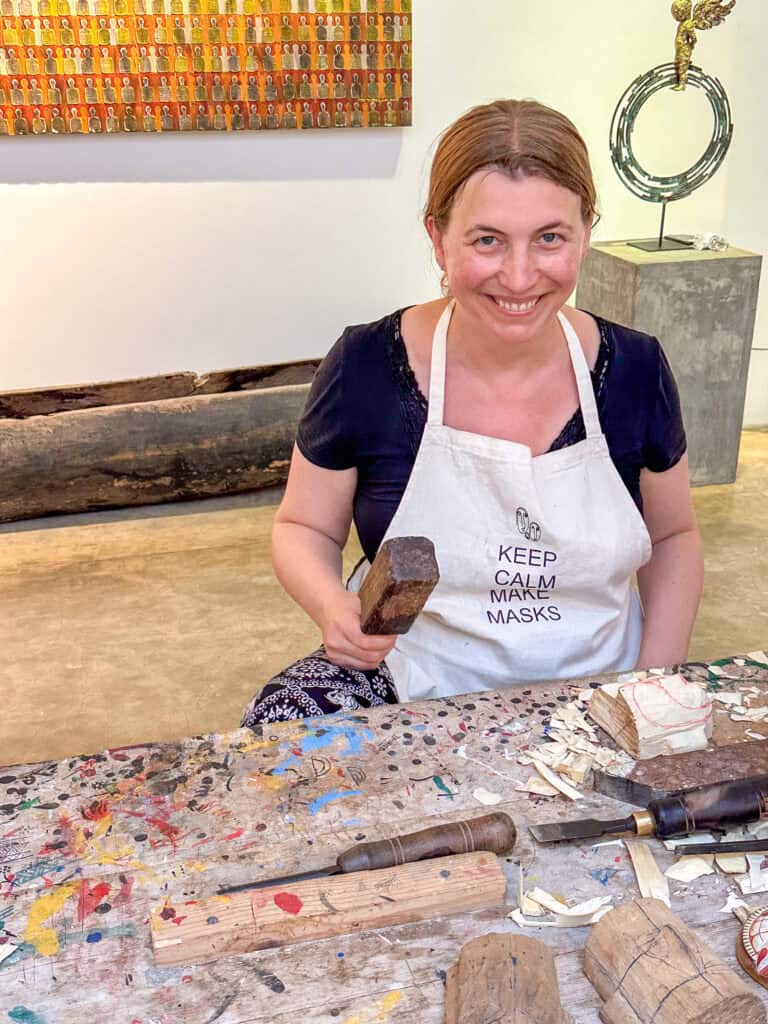
Raksha: fighting off demons
Raksha means “demon” and the masks are apotropaic, a wonderfully evocative word that describes the desire to ward off evil. They are the stone gargoyles of medieval Europe, only bold, bright and beautiful.
Traditionally, people use the masks for festivals and storytelling but they’re also, I’m told, sometimes hung in, around and on houses as a sign of good luck.
I signed up for this lesson because, in a pattern of behaviour that will not surprise my friends and family, it seemed a good idea at the time. The other option available involved relaxing in a gorgeous hillside hotel, a room with views across the forest and its own plunge pool.
But I couldn’t help myself. I wanted to learn more.
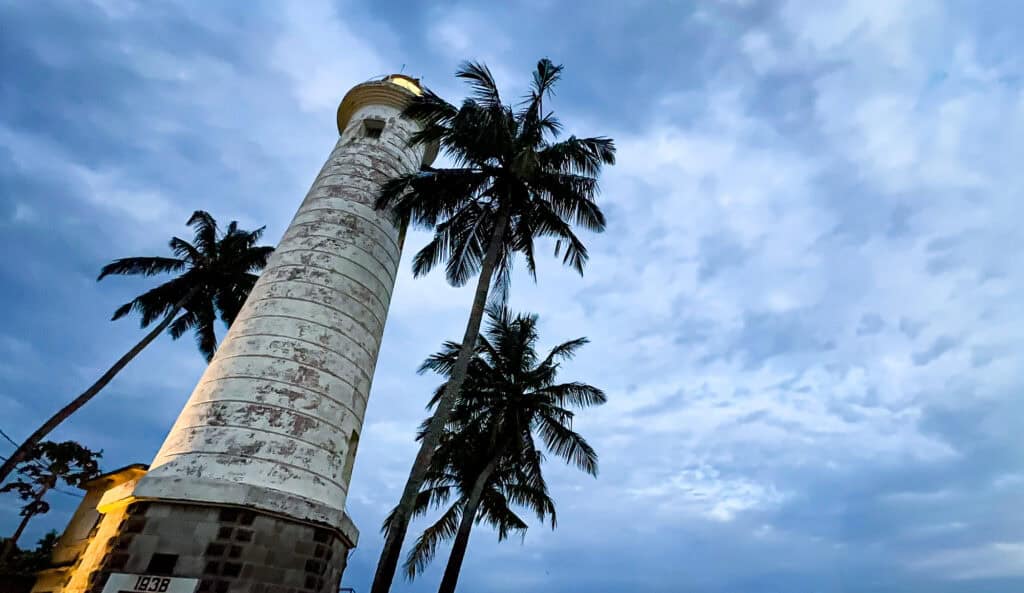
Exploring Sri Lanka’s past
Galle is popular, a staple on the tourist map, along with Colombo, Ella and Kandy.
But our trip has taken a different route. We’ve still followed Sri Lanka’s big hitters: elephant safaris in Hurulu Eco Park and climbing the 1200 steps to see the rock star swimming pool on the peak of Sigiriya. And we’ve driven past the beaches to scale the hillside temple of Koneswaram Temple in Trincomalee.
But we’ve spent most of the time in the north, basing ourselves in Jaffna, the main city and heartland of the Tamil population.
Speaking in extremely broad (and therefore flawed strokes,) Sri Lanka’s population divides into two main groups. The Sinhalese at around 74%, who follow Buddhism, and the Tamils, at 11%, who live in the north and some areas to the east and tend to practise Hinduism. You’ll also find Christians and Muslims, Burghers and Moors, but as I say, broad strokes at first.
To the young and uninitiated, the Tamil Tigers may sound like a cooler version of Paw Patrol but instead they represent the armed contingent of one side of Sri Lanka’s brutal Civil War, which ran from 1983 until 2009. Or in other words, recently, and remembered by all but the youngest people you’ll meet.
On this visit alone, I’ve heard that there are those who despise even the term Civil War, feeling that it doesn’t accurately describe what happened here.
And while scars take time to heal, I’ve not felt any sense of threat during our time here.
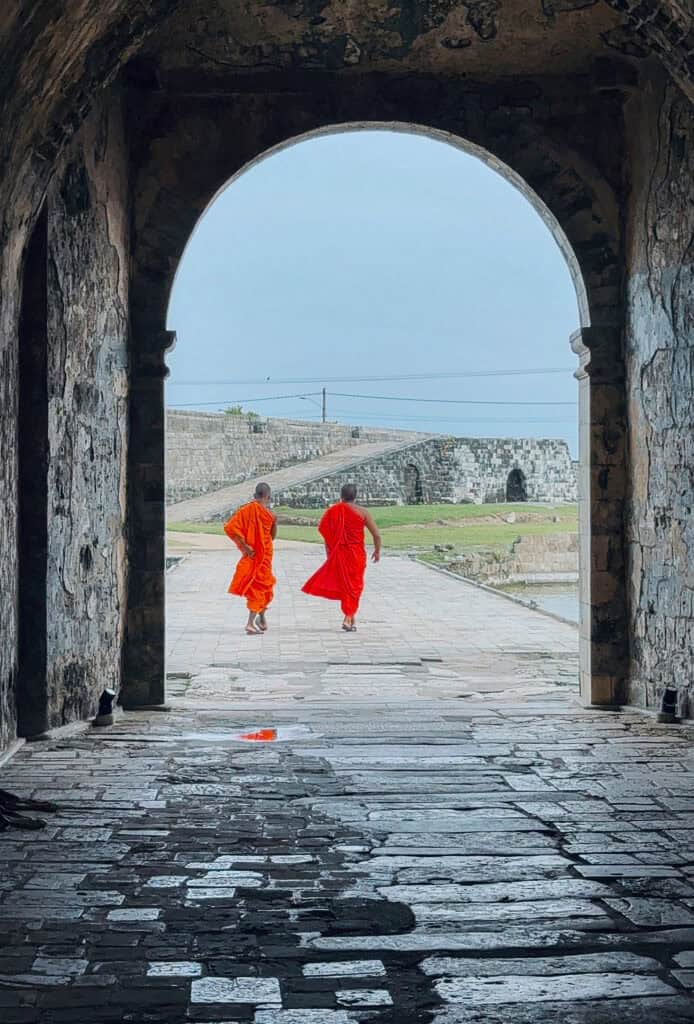
What is it like to travel through Sri Lanka now?
In Keerimalai, we swam with local people, the water soft and warm. In stop off points on the road to the north, families asked to take my picture and children to feel my hair. I walked, blissfully ignored, through commuter crowds on the streets in Jaffna, between the jackfruit and jaggery stands.
And around Sigiriya and Galle, we just blend into the normal tourist crowd.
- Discover more about these popular tourist spots on our Sri Lanka travel information page.
Officially, Sri Lanka wants to put its past behind it, to open up tourism and bring international friendship, commerce and partnership to the fore.
But it doesn’t want to lose its past. Beyond carving wooden masks in Galle, we’ve tried traditional calligraphy with charcoal on ola leaves at the Ridi Vihare Cave. We’ve taken a cooking class on the banks of the Hiriwadunna Lake, pairing weaving with milling and grating fresh coconut. We’ve visited colonial forts, chanted with monks, sketched and walked barefoot through candlelit temples.
And now, I can say, I’ve carved my own demonic mask.
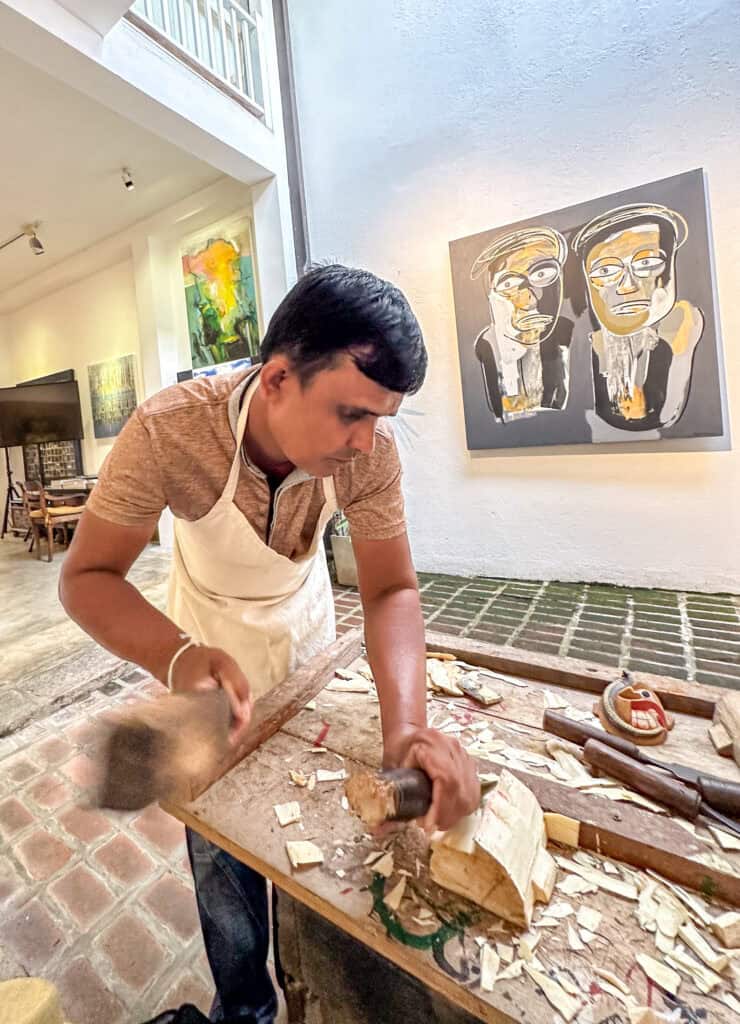
Beneath the mask
The perfect end to my story and reflections here would be to see the masks in action, to attend exorcism rituals and dance performances to ward away the evil spirits.
But there hasn’t been time. This time. So instead, as I whittle away and stop to wipe my own brow, shaking out the cramps in my hand, I’m thinking of the idea of masks in general.
After all, not only can masks scare off demons. They can hide them, too.
They conceal, they reveal, they invite performance and provoke reflection. In carving mine, I’m left wondering: do we wear masks to become someone else, or to become more of who we are?
Here in the soft scrape of balsa wood, there’s no time nor room for pretence. Perhaps that’s the real power of a mask? Not to frighten demons away, but to coax them into the open, where they begin to lose their power?
And perhaps that works for nations, too.
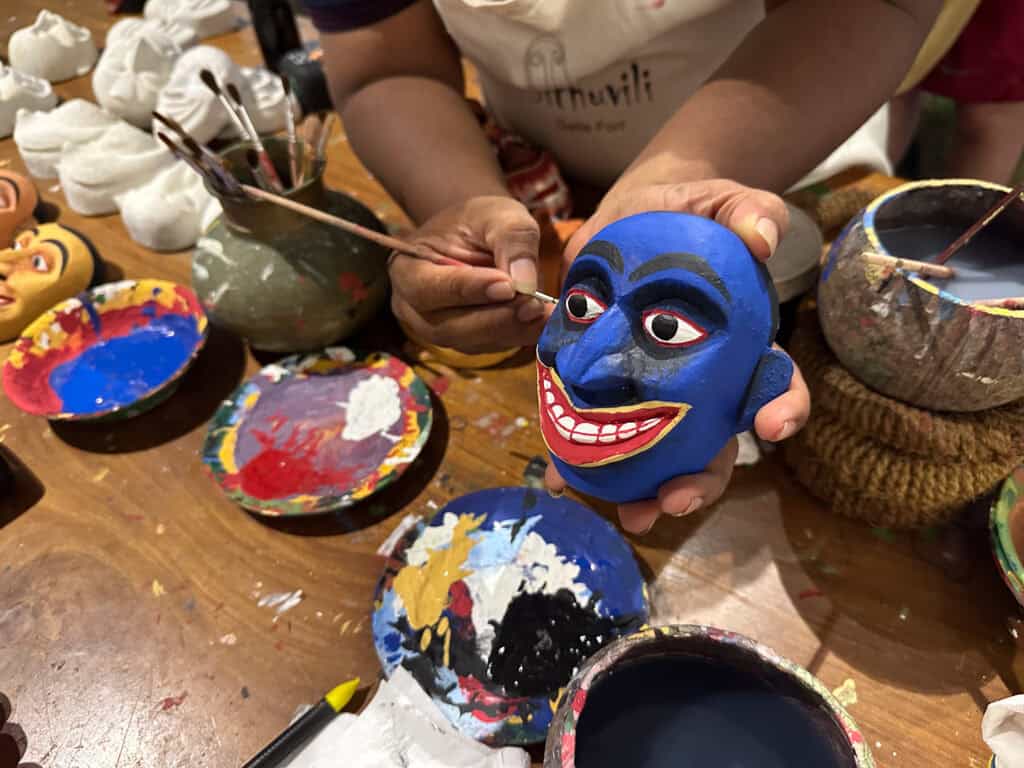
But in that small workshop in Galle, with Chaminda and Harin and shavings at our feet, I realised something else.
These masks weren’t about hiding. They were about showing up.
About choosing to face something, even if it’s just your own clumsy carving and the awkwardness of language barriers.
And perhaps that’s the bigger point.
To complete my traditional Sri Lankan mask, it needs to be painted, the rough edges smoothed. But there isn’t time for that on this trip and, to be completely honest, I rather like it that way.
After all, it carries with it the promise to return, my time in Sri Lanka unfinished. For all the right reasons and in the best possible way.
Is it worth visiting north Sri Lanka?
What are traditional Sri Lankan masks?
Carved from wood and painted in bold colours, Sri Lankan masks have a rich history with influences from southern India. Skilled artisans carve intricate details onto devil masks, which can be used in religious ceremonies, dance performances and traditional healing rituals.
The naga raksha mask is one of the most well known, depicting a cobra who enslaves enemies. Beyond the cobra king, you can find many different forms, like the gurulu raksha, which is a supernatural bird who devours a snake and the mayura raksha, a peacock which brings peace.
A traditional Sri Lankan mask had a crucial role in ancient times in protecting against high fevers, stomach and skin diseases and parasitic worms as people believed they had mystical powers.
Recent years have seen the decline in the traditional dances that accompany mask use but you can still find some in rural areas and the mask museum in Ariyapala.
To try your hand at the traditional techniques, visit the Galle Art Fort Gallery.
For a beautiful place to stay near Galle, visit Malabar Hill.
And for transport and guides, check out Blue Lanka Tours.
Disclosure: Abigail King travelled to Sri Lanka as part of a project with Sri Lanka Tourism. As ever, as always, she kept the right to write what she likes.
About Abigail King
Abigail King is an award-winning writer and broadcaster who has worked with the BBC, UNESCO, the EU, NASA and more.
She’s the founder of Inside the Travel Lab, described by National Geographic Traveler as “Essential Reading” and Lonely Planet as “one of the best travel blogs in the world.”
Read more about traditional arts and crafts in Sri Lanka here.
Buy the Sri Lanka Guide Book
For more information, see our guide to Sri Lanka:
